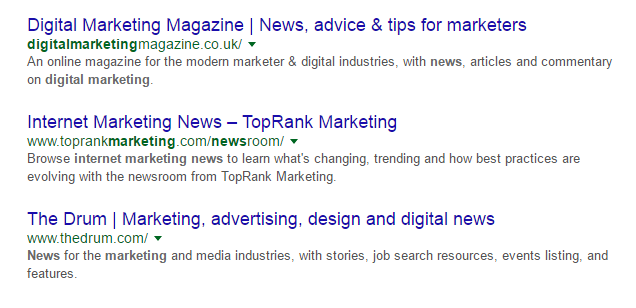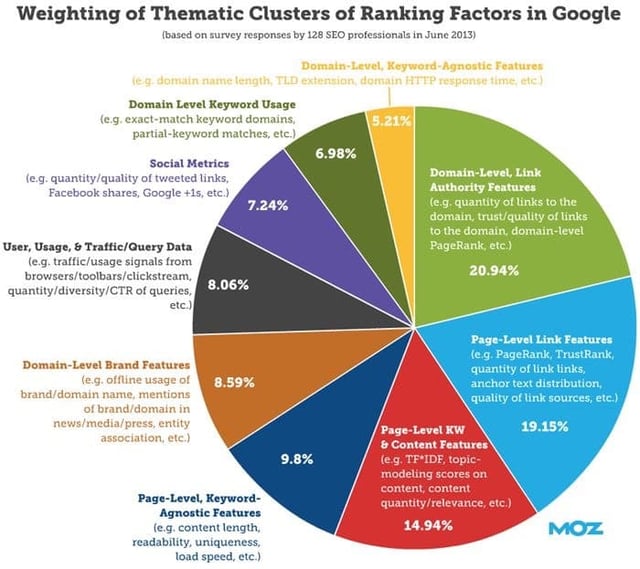So you’ve got a tech company and have decided to bite the bullet and finally get your head into the highly profitable, but nitty-gritty area of search engine optimisation (SEO), either to aid your marketing services in general, but hopefully – and specifically, to aid your inbound marketing.
It doesn’t matter though if you’re not yet following an inbound route. This post is designed to help you regardless.
By this point, you probably realise that it’s a big job, and perhaps you’re feeling a little overwhelmed.
No need.
As a leading inbound marketing agency that specialises in tech companies, we've made a name for ourselves by taking deep, complex subjects such as SEO and breaking them down into logical, easy-to-digest, and highly actionable steps.
Technology companies tend to be among the ones that can benefit from SEO services the most. So, deciding what direction to take when it comes to search engine optimization will dictate how your site performs.
In this post, we will dive into everything from what on-page SEO elements are, how to come up with a winning SEO strategy, the importance of technical SEO for your SEO performance and whether you'd benefit from an SEO agency or doing it in-house.
So put the ibuprofen back into the desk drawer, grab a fresh coffee and let’s get stuck into SEO for tech companies: The Ultimate Guide.
How to Get the Most From this Guide
The best way for you to use this post depends on your circumstances. But it’s important to consider, because the strategies below give you serious power to generate traffic.
More traffic means more leads, and more leads means more revenue for your tech company.
By deciding your approach up front, you’re much more likely to follow through and get the value. Two example approaches are:
- Put aside an afternoon to plan, set up your tech SEO tools and begin implementing strategies
- Print out a hard copy of the guide and treat each subheading like a to-do list item, crossing them off as you return to the guide and complete each one (the hard copy will help you keep track of how far through you are)
Section 1: SEO Preparation & Strategy
The biggest mistake made by tech companies, whether they’re following an inbound marketing route or not, and for others embarking on SEO for the first time, is a failure to plan a coherent strategy. Another even more overlooked factor is that in order to succeed, we must understand how Google sees things.
Once you understand this, you can make decisions that will result in highly targeted content.

Key takeaway: Don’t arbitrarily create content. Don’t start optimising until you have a legitimate strategy. This strategy should be part of your overall tech marketing strategy.
- Help Google with its goals, and it will help you with yours
There are of course other search engines, but these are peasants compared to the dominating force of King Google, so we're going to focus on that for now.
This search engine turns over around $40 billion annually from pay per click (PPC) advertising and their process looks something like this:
- Someone types a search phrase into Google
- They’re shown the results page
- They click either on an organic result (yay for you) or a PPC ad (yay for Google) hoping for a quality result
When a PPC ad is clicked, Google makes money. But, the reason people go to Google in the first place is because it provides such high quality results on the first page.
Google’s goal is to list the highest possible quality content on the front of its search engine results’ page (SERP) so people keep using it and it can keep making money on those PPC ads when they return again and again.
Never underestimate the power of that statement. Whatever changes are made to the algorithm, whatever happens in this field, quality will always come first. It’s how Google protects that $40 billion per year revenue stream.
If you make your content the best out there for any given keyword, you have a chance at the front page.
Key takeaway: Google must list only the best quality content for any given search phrase on the front page. All decisions about your SEO must be made with this goal in mind. No amount of good SEO makes up for crappy content.
Start With Keyword Research
By now, you probably know a search phrase is called a “keyword”, and there are three factors that go into understanding how to identify a juicy target phrase that will make you money.
Buyer Intent
There are hundreds of sites in search engine results pages, and you want your prospects to be thinking about buying from you. Therefore, one aspect of your SEO that must be considered up front is buyer intent. When you’re thinking about that, prioritise website pages and other content that contain words like:
- Buy
- Purchase
- Shipping
- Install
- Pricing
- Price
- Cost
These are good examples, but any other words you think clearly indicate buyer intent for your tech services should be your priority. That way, you'll get faster results from this guide.
Search Volume
It’s important you target keywords that have as high a search volume as possible.
If something has 500 searches per month and you secure a coveted front-page position in the Search Engine Results Page (SERPs), you won’t get all the clicks from those 500 searches, even position one may only get 40% (as a rule of thumb) of those searches.
So it’s important to go for as high a search volume as possible for your services. But what’s the catch? Make sure you don’t fail to take buyer intent into account.
You can monitor your performance in a variety of different tools like Google search console or SEMrush.
Competitiveness
If you’re serious about undertaking SEO for your tech company, you must find a tool (which we’ll get to in a moment) with some kind of keyword competition analysis feature.
Because even if the traffic volume looks good and the buyer intent makes sense, if you have to compete with many very high authority websites (the Domain Authority), it can take a very long time to rank.
If your tool shows a low competition rating for your keyword, you know you can work with it to generate a faster 1st page position in Google.

Key takeaway: You must strike a balance of the three factors listed above
- Search volume is as high as possible
- Competition rating is as low as possible
- Buyer intent is as clear as possible
Section 2: The Right Tools for Getting Ranked in Organic SEO
There are a myriad of SEO and marketing tools out there to make your life a lot easier – after all you’re also running your tech business.
One slight difference with SEO tools is that they don’t just make your life easier but are fundamentally essential for the job at hand.
You need good tools to do good work.
Too many SEOs these days still rely on the basic Google Adwords’ tools alone. It’s a woefully inadequate strategy if you’re serious about getting the first page rankings you need to generate more leads.
Keyword Research Tools
The keyword research tool you settle on is largely down to preference. But, as above, some kind of competition analysis feature is essential for the job. Here are three good examples
1. SEMRush
SEMRush is an incredibly versatile keyword research tool which provides insights into your competitors paid and organic search results
2. Longtail Pro Platinum
Longtail Pro (you’ll need the Platinum upgrade) is from the affiliate marketing space, but some of these guys really know how to do profitable keyword research.
3. Authoritymetrics
Authoritymetrics is another good example with lots of competitor analysis features, in addition to the keyword competition rating you need.

An example SEMrush dashboard
There's also a couple of other handy tools you should make a note of:
SEOBooks – keyword density analysis
We’ll look at keyword density shortly, but meanwhile, make a bookmark of this tool from SEOBook. It’s the best tool for the job of analysing keyword density.
AHrefs – competitor research
When you embark on your tech SEO campaign, you go to war. There are only up to 10 positions on Google’s front page and you need to beat the opposition.
In The Art of War, military general and philosopher, Sun Tzu, famously said:
“Know your enemy and know yourself, find naught in fear for 100 battles.”
Ahrefs is the tool for the job. You can take a competitor’s website URL, run it through this tool and get a comprehensive analysis of the backlink profiles, scouring through them and see if there are any you can steal. You know what you’re up against and “know why enemy”. We’ll come back to this point later.
A backlink is also known as an incoming link. The link comes in from another relevant site to yours. If the site has a higher domain authority than yours, this builds a profile of trust and credibility with your site, with the search engines. So for example, a backlink from the BBC would prove very helpful.
Browser plugins
When you’re seeking a backlink opportunity, you need to know the authority of the websites so you can determine whether or not they’re worth your time.
We’ll go into this later, but for now, here are two excellent tools for the job.
- PageRank
PageRank is a metric created by Google to give a website an indexed score of 1-10 that shows how authoritative it is (typically with a strong correlation to the number of backlinks and different domains it’s build up over the years).
Downloads for: Google Chrome | Mozilla Firefox - Mozbar
Moz has its own authority algorithms that show how authoritative a website is. SEOs have largely moved away from PageRank and now use MozRank instead, as unlike PageRank, it is much harder to manipulate. Knowing a site’s PageRank is a good start, and the Moz toolbar gives you more detail and many people find it more granular as goes to two decimal points e.g. 5.75.
Downloads for: Google Chrome
We’ll go into what you should look for later.
Section 3: Onsite SEO Fundamentals to Build Organic Visibility for Your Tech Company
Broadly speaking, SEO takes two forms: onsite and offsite.
We’ll begin by looking at how to get your own site straightened out, partially because it’s a logical starting point, but also because many of these concepts can be applied to your offsite SEO too.
Measuring Your Keyword Density
Over the years, you may have heard about a concept called “keyword density”. There was a time when this meant “stuffing” as many verbatim or “exact match” repetitions of your keyword as possible into the content.
These days, that practice will buy your content and your visibility a first class ticket to the fiftieth page on Google’s results where they’ll be stuck for the rest of eternity.
So what percentage of your content should contain the keyword you so carefully selected? Honestly, no one knows for sure because Google guards how its algorithm works to avoid people taking advantage.
But, many experts agree that the “exact match” of a keyword repetition in its complete form should appear no more than 1%-3% in total. You can improve your keyword relevancy by using semantic variations of the same word.
For example, if your target keyword is “managed services UK”, you can say things like:
- managed service companies in the United Kingdom
- providing managed services in England, Scotland, Wales and Northern Ireland
- managed services available in the UK
And so on and so forth. Above all, remember that Google’s algorithm changes and remember that its modus operandi is quality results for users.
Key takeaway: As long as you don’t stuff too many exact match keywords into the content and mix up the semantic variations, you should stay on track for good keyword density.
Formatting Metadata
With each passing month, Google’s so-called “spider bots” that crawl your content before indexing, are getting smarter and smarter.
They can see the content you’re publishing, they understand the semantic relevance between words, the target keyword and much more besides.
However, it’s still important to format your content properly to make it as easy as possible for them to read, especially as you’re going through all this trouble of creating top quality content in the first place.
- Title tag <title> – should contain the keyword and be a maximum of 55 characters
- Header tag <h1> – typically the same text as the title tag and contains the title of a page
- Subheader tags <h2> <h3> <h4> – your subheadings should use markups (a defined structure), opting for larger numbers as you get more granular with the points made in your content
- Meta description – should contain the keyword, an enticing description of the content and be a maximum of 160 characters. This is important to get people to click through from the Google listings. Sometimes you can get people to click on your result ahead of higher-placed competition based solely on a good call to action in the description.
- Alt tag – found in the image section of your CMS, should contain a text-based description of what the image shows, making sure you include a keyword.
Learn about Hubspot CMS Migration
Where you find these items in your CMS depends on which one you’re using for your tech company. If you’re confused, speak to someone on your team with even the most basic HTML knowledge and they’ll show you how and where to implement the above.
 The above shows three well-optimised examples that have targeted titles and meta descriptions that are within the length limits.
The above shows three well-optimised examples that have targeted titles and meta descriptions that are within the length limits.
Key takeaway: Always format your metadata ensuring it’s properly laid out and organised, so Google’s spider bots have an easier time understanding what your content is
URL Structure
Your URLs should follow a logical structure that makes it easy for Google to see what your content is about. Shorter is also better, so try to minimise the length where possible. Here are two examples of good URL structures:
- http://yourtechsite.com/exact-match-keyword-blog-post-url
- http://yourtechsite.com/blog/exact-match-keyword-blog-pos-url
And here are two that are not so hot:
- http://yourtechsite.com/how-to-get-an-exact-match-keyword-blog-post-into-a-url-that-is-simply-too-many-characters-long-and-loses-your-keyword-among-the-noise
- http://yourtechsite.com/blog/category/subcatgory/sub-subcategory/how-to-get-an-exact-match-keyword-blog-post-into-a-url-that-is-simply-too-many-characters
You can see in the second example that, in addition to the URL being far too long, the post is lost among all the different categories and subcategories of the site. It adds to the length and convolutes the structure of the URL.
Key takeaway: Do what you must to ensure a short, concise URL that will be easier for both Google and your readers to understand.
Website information structure
Whether you’re creating a new website for your tech company or overhauling an old one, it’s important to consider your information structure.
This means how you group your web pages, menus and categories. The key idea is to ensure they’re logically organised into as few groups as possible.
Put another way, that means avoiding the temptation to create lots of categories for all of your different products and services.
Depending on your business, this one can be tricky. If you provide a lot of services, you will probably need a lot of categories. Just look for ways to streamline those categories so your URLs can be made clean, not to mention, your site being a lot easier to navigate.
When deciding what categories to have at the “top level” (i.e, they’re not subcategories), also consider your keyword research. For example, if one group of keywords gives you the highest volume and looks like it might be the most profitable, incorporate that factor into your decisions.
Key takeaway: Don’t arbitrarily put together a website information structure. Make it as streamlined as possible, taking into consideration the keywords your target audience is using the most.
Section 4: Offsite SEO Fundamentals
While much of the SEO for your tech company will be done on your own site, many of Google’s ranking factors look to how your site is discussed and represented on other people’s sites.
This brings us to the realm of offsite SEO. Examples of offsite SEO include:
- Guest posting on relevant websites for backlinks
- Other types of backlink such as blog comments, forums, review websites
- Social media mentions and engagement in general
All of the above are relevant and taken into account by Google, especially your guest posting. Onsite SEO principles such as keyword density and proper metadata formatting are relevant here, too.
How to Linkbuild
Although less common now, you may sometimes see unscrupulous vendors offering hundreds or even thousands of backlinks for a single fee. Proper link building is a slow, deliberate and often arduous process. So if it feels slow and arduous, you’re probably doing it right.
For new sites in will take 6-12 months to start getting consistent traffic.
If you rush things, Google’s algorithm will think you’re trying to game it into thinking you’re a bigger and more important website than you really are with all of these backlinks. And that will lead you to getting penalised and slapped down the SERPs.
First Steps For Building the Link Profile for Your Tech Company:
Look at the connections you have in your industry and ask them for a link. Also, join industry organisations and federations – these are quick ways to build powerful backlinks.
There are four key ideas that must be observed when building your backink profile:
- Link Quality
This is based on the authority of the target website and its relevancy to your product or service. Using the PageRank and Mozbar tools listed above, websites must have:
a. A minimum domain authority (DA) of 20. The higher, the better.
b. Links within text are better, rather than standalone links that are in a list, for example
c. Ideally you don’t want a link on a page with tons of other links. This dilutes the power of the link
If you pick up lower authority links than these metrics, that’s fine. But don’t go too far out of your way to secure them. Likewise, if the authority of a possible backlink is double or more of what’s listed above, you know it’s worth investing more of your time to secure the link.
2. Link Velocity
When building your backlink campaigns, start off with just a few in the beginning, and then build up momentum thereafter.
You have a margin for error here. There is no hard-and-fast rule. But don’t (for example) go crazy putting up 100 backlinks in the first month of a site going live, then make no effort for 3 months after that. It’s that kind of negative velocity you want to avoid.
3. Number of different linking websites
Here is a quick quiz for you:
Which do you think is better?
Option A – 1000 links from two websites or Option B – 500 links from 25 different websites? Answer: Option B.
It’s better to have lots of links for your offsite SEO from many different websites that are relevant to your tech company, than lots of links from one or two websites.
The more backlinks you have from different domains that are relevant and good quality, the better. In addition to your own link building, the blog posts and offers you create and send out will build natural backlinks of their own. Stay consistent, keep publishing, and quantity will come over time.
- Link Variety
Finally comes link variety. This means you should have a decent mix of backlinks from different types of websites such as:
a. Quality content posted on industry-relevant sites e.g. Techcrunch
b. Valuable comments posted on industry-relevant articles
c. Backlinks on forums and other industry-relevant community sources
d. Review sites such as Yelp
e. Links from social media, especially LinkedIn, make you look legitimate.
The idea here is to make your backlink profile appear natural. As if people and relevant forums are talking about your brand.
Research Your Links and Your Competition’s
Depending on your current circumstances, your backlink profile may be holding you back.
Either you, someone working at your company, or someone who worked as an outsourced SEO may have purchased bulk backlinks or otherwise deviated from the link building best practices listed above.
Use the tool mentioned earlier, Ahrefs, to check your own backlink profile and see that there are no spammy bulk purchases that could have raised a red flag for your site.
If there is, you’ll need to disavow those links using Google’s Disavow Tool.
Conversely, use Ahrefs to check your competitor’s backlink profiles to gain inspiration for where you might secure juicy links of your own.
Key takeaway: Use the Ahrefs tool to examine your backlinks and those of your competition. Pinch the best links from your competitors.
Sharing Content in Social Media Channels
Okay so this isn’t a guide about social media marketing. But the bottom line is, social media makes a contribution to your search engine optimisation, too. The chances are you’re probably using an automated social media posting tool to post regularly in the main social channels.
You should have at least a Facebook, Google+ (it may not have a huge userbase, but it is targeted and there are rumours that Google gives preference to content that's shared there), Twitter and LinkedIn account posted to regularly. You never know when someone will pick up a piece of content and give you backlink for it, even if they’re not typically your most profitable marketing channels.
Key takeaway: It’s often a good idea to use the four main social media channels above for sharing content. But whatever sources you find work best for your tech company, make sure you post content regularly to tick this box in your SEO campaign.

Section 5: Tips to Stay on Track
How Google’s Algorithm is Weighted
When you follow the strategies in the guide above, you’re in good stead to secure those coveted and highly profitable 1st page positions in the SERPs.
While it’s not by any means essential to understand how Google weights its algorithm, (not least of all because it evolves regularly) it is a good thing to see just to give you a feel for how things work.
Here’s an excellent chart put together by the team at Moz showing an estimate based on a survey of over 120 top industry professionals.

Structure Your Writing For Your Readers
Another thing that gets Google concerned is high bounce rates. That means, although it doesn’t have a direct effect on your SEO, breaking up your information to make it as digestible as possible will keep readers on your page, lower your bounce rates and consequently, help your SEO.
If you want a good example of how to break information down and make it easy to read, just emulate the way we’ve done it in this guide.
Perform Quarterly Reviews
Search engine optimisation is a lot like the conversion rate optimisation for your lead-generating landing pages; it’s not a “set it and forget it” task.
By setting up quarterly reviews you can check your progress and continually adjust your course until it’s moving in the most profitable direction. Examples of questions to ask in the review include:
- Has our backlink profile grown sufficiently over the past three months?
- How does its growth compare with the link velocity of our key competitors?
- Did the keywords we expected to have the strongest buyer intent prove to be correct?
- Have recent tech industry events affected the keywords our target audience will be using?
- Are we making progress up the SERPs?
By monitoring your progress and seeing which parts of your campaign need tweaking every three months, you’re significantly more likely to stay on track, exceed targets and most importantly, beat your competition.
Key takeaway: SEO is not a “set it and forget it” practice. Ensure you set up quarterly annual reviews for your progress.
Never Stop Learning…
SEO for technology companies or any company/industry changes each and every day. And, when you’re working in the ever-changing tech environment, it’s important to stay ahead of the curve if you want to secure your fair share of the leads.
As discussed, SEO is not a one-size-fits-all practice, if you are a local business, you will benefit from local SEO practices like Google My Business optimisation and ensuring your information is accurate so that potential customers can find you on Google Maps and improve your organic traffic.
The search engine optimisation landscape changes each and every day. And, when you’re working in the ever-changing tech environment, it’s important to stay ahead of the curve if you want to secure your fair share of the leads.
There are a number of excellent resources such as Search Engine Land, Search Engine Journal, and excellent series such as Whiteboard Friday from the Moz team.
All this sound like a lot of work? Well, the honest truth is… it is a lot of work. And there’s a lot more to search engine optimisation besides what’s here.
However, stay with the programme and over a period of time you’ll see the benefit of SEO for your tech company.









